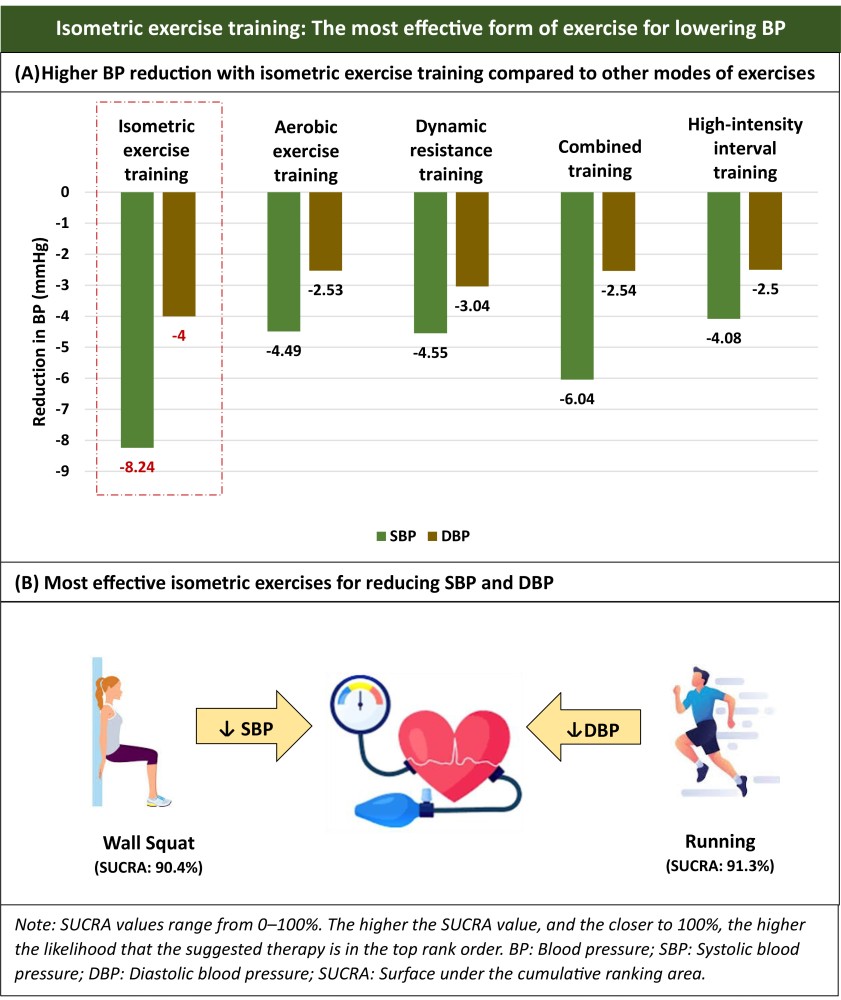
Exercise training is one of the proven lifestyle modification techniques for reductions in blood pressure (BP) in people with hypertension [1].
Isometric exercise training (IET), also known as static strength training, is recognized as a potential modality for lowering both systolic BP (SBP) and diastolic BP (DBP). It involves static, tightening (contractions) exercises of a specific muscle or a group of muscles. These exercises help build and maintain strength and can be performed anywhere [1].
A recent study by Edwards et al., published in the “British Journal of Sports Medicine”, documented the value of IET in improving resting BP and concluded that IET can be recommended for the prevention and treatment of arterial hypertension [2].
This systematic review and network meta-analysis included 270 randomized controlled trials (n = 15,827), published between 1990 and February 2023. All the studies reported reductions in SBP and/or DBP following an exercise intervention of ≥2 weeks compared to a non-interventional control group. For uniformity, the protocol of each published paper was screened against the exercise prescription in Everyday Practice and Rehabilitative Training tool to be defined and categorized. The protocols were then grouped into aerobic exercise training (AET), dynamic resistance training (RT), combined training (CT), high-intensity interval training (HIIT), and IET. The protocol was further stratified into subgroups – AET including walking, running, and cycling; HIIT including sprint and aerobic interval training; and IET including isometric leg extension and isometric wall squat. Resting BP was categorized as healthy (<130/85 mmHg), pre-hypertension (130–139/85–89 mmHg), and hypertension (≥140/90 mmHg) [2].
The study results are summarized below [2]:
- All modes of exercise led to higher reductions in SBP in normal BP cohorts. Reductions in BP were substantially larger in patients with hypertension.
- Pairwise analyses revealed greater reductions in resting SBP and DBP following IET, AET, RT, CT, and HIIT (p <0.001 for all).
- In the network meta-analysis, the rank of effectiveness for SBP based on surface under the cumulative ranking area (SUCRA) values was the highest for IET (SUCRA: 98.3%), followed by CT (75.7%), RT (46.1%), AET (40.5%), and HIIT (39.4%).
- Secondary network meta-analyses revealed that among IET methods, the most effective mode for reducing SBP was isometric wall squat (90.4%), and for reducing DBP, it was running (91.3%) (see graphic).

Clinical implications [1,2]
- The study findings highlight the need to prioritize isometric exercises to improve systemic vascular resistance in patients with arterial hypertension.
- Combining such form of exercises with aerobic and dynamic resistance training exercise provides synergistic benefits in the management of hypertension.
References:
1. Rickson JJ, Maris SA, Headley SAE. Isometric exercise training: A review of hypothesized mechanisms and protocol application in persons with hypertension. Int J Exerc Sci. 2021;14(2):1261-76.
2. Edwards JJ, Deenmamode AHP, Griffiths M, et al. Exercise training and resting blood pressure: A large-scale pairwise and network meta-analysis of randomised controlled trials. Br J Sports Med. 2023:bjsports-2022-106503. Doi: 10.1136/bjsports-2022-106503)
